Pros
Cons
Introduction
In a market saturated by feature-heavy HDTVs boasting everything from full HD 3D and expansive smart platforms, to voice and gesture controls, the L55B2181 is a rare bird. It's a 1080p LED television, and that's about all the description it requires.
While we've as of yet been unable to track down an official MSRP for this TV, it retails locally and online for around $999, though some sites are selling it for only $700.
In the tradition of Haier HDTVs, the L55B2181 is as no-frills as they get these days. No 3D, no internet content, and--unfortunately--no consistently good core performance. This Haier is cheap, not only in price tag, but in the way it looks and sounds during use. It simply isn't a good product, and there are numerous TVs on the market that'll give you more value for your money.
Design
There's very little good to say about the Haier L552181, at least within the arena of design details. Many of the TVs we've reviewed this year have had interesting aesthetic additions, but Haier's budget-targeted TV is as "plain Jane" as they come.
Its got a rectangular, charcoal-black bezel and a platform base that screws into the bottom of the TV. The L552181 doesn't swivel or tilt; we would call it average-looking, but lately the average-looking TV is either thinner, sleeker, or more interesting in some way than this Haier.
The Haier's controls are placed, standard, along the right side of the TV. It's ports are--for some reason--all shoved into a recessed area at the center of the TV's back, in a way that makes them hard to get to.
Overall, this TV's bringing nothing to the table.
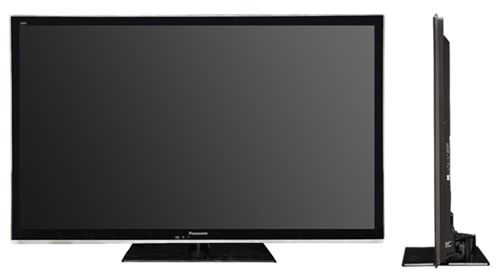
Front
{{section_header}}{{section.name}}{{/section_header}}

Back
{{section_header}}{{section.name}}{{/section_header}}

Sides
{{section_header}}{{section.name}}{{/section_header}}

Stand/Mount
{{section_header}}{{section.name}}{{/section_header}}
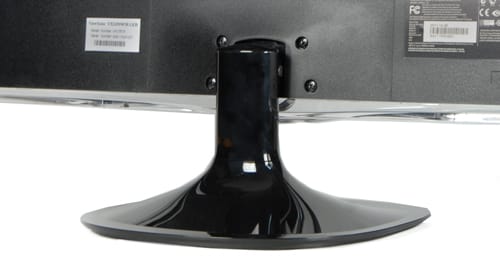
On-set Controls
{{section_header}}{{section.name}}{{/section_header}}
The four manual control buttons are located along the right side of the TV.

Remote Control
{{section_header}}{{section.name}}{{/section_header}}
The little remote that comes with the Haier L55B2181 is of standard infrared quality. There's nothing unusual about it. You'll find platforms for channel and volume, a 0-9 number pad, and buttons for power, source, and menu. Because of its size, all of the buttons are well within thumb reach.
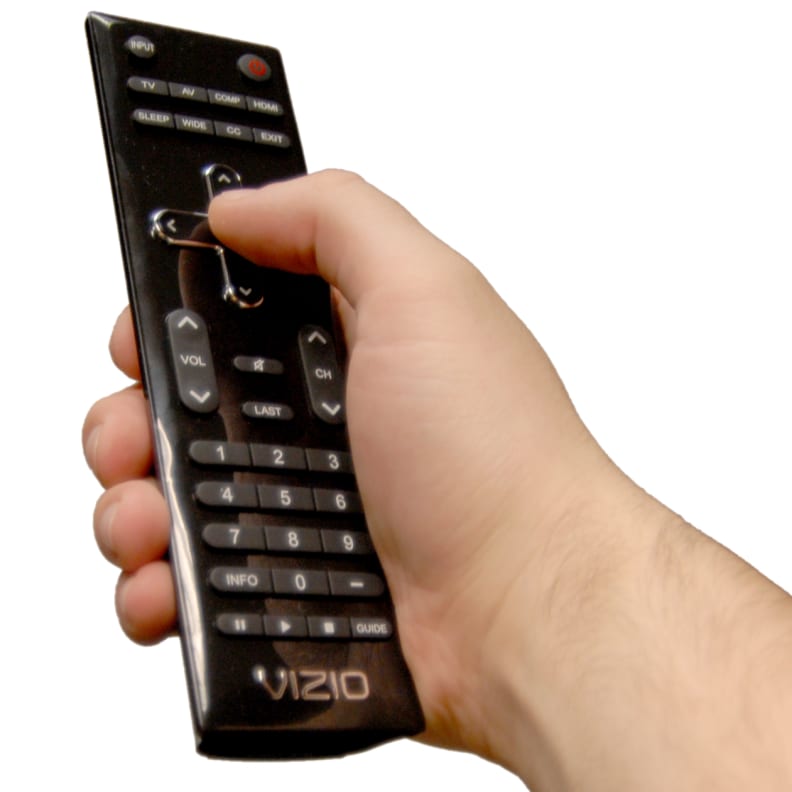
In the Box
{{section_header}}{{section.name}}{{/section_header}}
In the box, you'll find the display panel, power cable, stand components, eight screws, remote, two AA batteries, warranty information, quick-start guide, and instruction manual.
Connectivity
{{section_header}}{{section.name}}{{/section_header}}
Many modern HDTVs feature two input or port areas, but all of the Haier L55B2181's ports are located within a single large, recessed area on the back of the TV, right at the center. This is a touch problematic, because a 55-inch TV that doesn't turn or swivel can be hard to reach around, to say nothing of larger models. They're also all vertically inclined, which can make changing HDMI or USB connections without the aid of eyesight a little tricky.
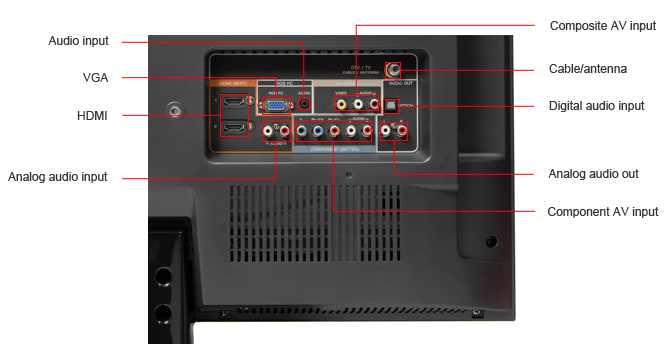
The Haier L55B2181 has a single USB port for video/audio playback, three HDMI inputs, a VGA pin input for your PC, a neighboring audio input for your PC, and an odd little set of composite/component and audio out that's clustered in the center of the port area. To the right of that, you'll find jacks for coaxial and RF cables, an audio out for headphones, and the input for the TV's 12v power cable.
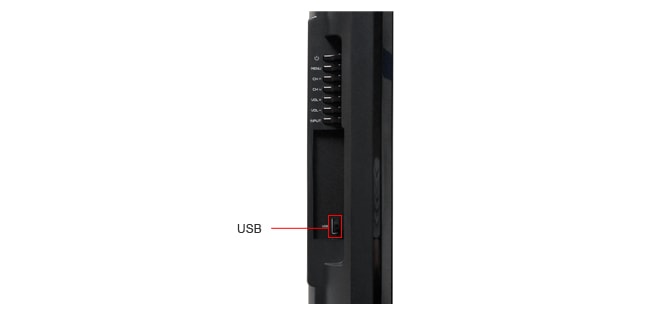
Performance
We went into testing and reviewing not expecting much from Haier's no-frills L55B2181, and we were accurate in (most) of our expectations.
This TV's got average color production and a stellar contrast ratio, but everything else about it is truly sub-par. We were able to see a lot of its drawbacks simply by watching regular film content, which is always a bad sign. The blurriness, cramped audio, and teeny viewing angle felt like a knock on the head.
There are 2012 TVs with worse color production, but this one takes the cake for being stacked with performance features that are a pain to both the eyes and ears. You'd be better off hollowing it out, jumping in, and paddling it down the river to your friend's place.
Contrast
{{section_header}}{{section.name}}{{/section_header}}
The three comparison TVs we pulled as competition for the Haier L55B2181 were not terrible TVs, but neither were they outstanding. A decent black level--the same as the Haier from 2011--and a very bright white gave the L55B2181 the greatest maximum contrast ratio out of all four TVs. This is a great result, and means terrific black/white differentiation. More on how we test contrast.
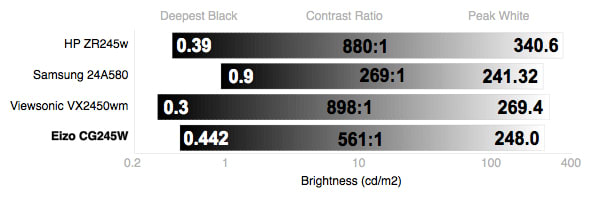
Color & Greyscale Curves
{{section_header}}{{section.name}}{{/section_header}}
These color curves are not good.
The red, green, and blue lines below represent those colors as displayed by the TV. The black line represents the greyscale.
As you can see from the chart, the curves are not uniform, and are fairly bumpy. This is going to result in a poor spectrum of colors from darkest to lightest, and to sudden jumps between colors/shades of grey.
This isn't awful, it's about average for a TV in this price range, but it certainly doesn't give any incentive to purchase. More on how we test color performance.
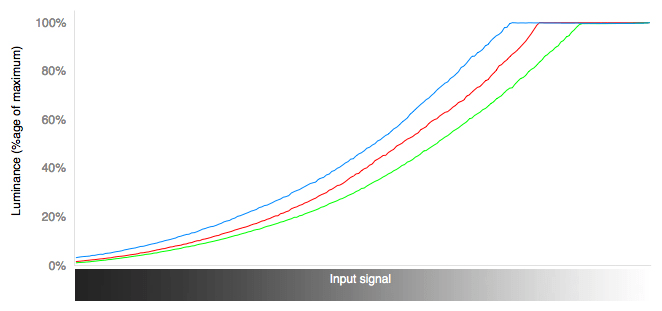
Color Temperature
{{section_header}}{{section.name}}{{/section_header}}
The L55B2181 showed us decent color temperature adherence. We use the chart below to help visualize how well the TV maintains its light "temperature," in Kelvins. The deviations from 0 show, in this case, a cooling off of that temperature, though nothing within the grey box will be perceptible during viewing.
What this means is that some shades of grey, particularly those towards the darkest end of the spectrum, are going to have an orange-like hue and not move naturally from/to the surrounding shades.
Most of the spectrum is not outside of the range of imperceptibility, which is a big thumbs up. Not a bad result at all. More on how we test color temperature.
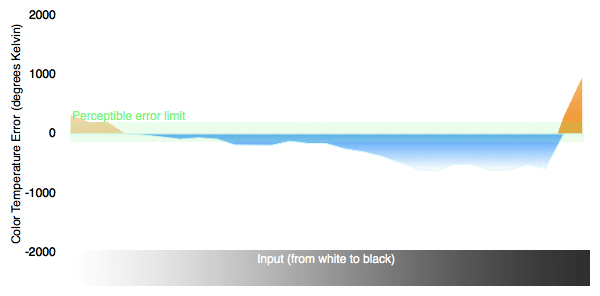
Color Gamut
{{section_header}}{{section.name}}{{/section_header}}
The chart below illustrates how well the L55B2181's color gamut--its peak red, green, blue, and white--matches the rec. 709 color gamut, which is the standard that HDTVs are expected to adhere to.
As you can see, the measured gamut did not perfectly match any of the ideal gamut's points, though it was relatively close. This isn't a terrible result, and is fairly usual, though we've seen much cheaper TVs that tested with a much more accurate gamut; the Haier's price is no excuse for this kind of performance. More on how we test color temperature.
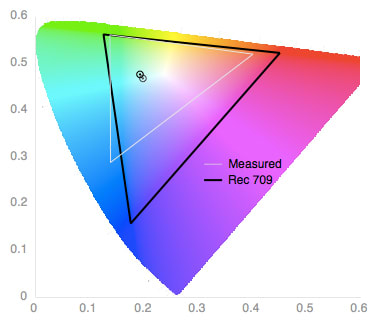
Picture Dynamics
{{section_header}}{{section.name}}{{/section_header}}
The Haier performed with above average results in the area of picture dynamics. For LCD televisions, we measure picture dynamics by testing how well a TV can level its whites/blacks. The ideal is that, no matter what percentage of the screen is white/black, the whites will maintain their brightness and the blacks will maintain their darkness, ensuring that the TV's contrast ratio is not just a measure of how well it performs given the rarity of a "full screen" of white/black.
The L55B2181's black level was not as consistent as its white level, but was not bad. Between a 100% white screen and a 5% white screen, the Haier got only slightly brighter at 5%, about 5 cd/m2 , which is barely perceptible to the human eye. More on how we test picture dynamics.
Resolution & Formats
{{section_header}}{{section.name}}{{/section_header}}
The Haier L55B2181 is a 1080p HDTV. It supports all NTSC resolutions and formats.
Viewing Angle
{{section_header}}{{section.name}}{{/section_header}}
The Haier L55B2181 tested with one of the most restrictive viewing angles we've seen, period. Its contrast performance drops below 50% of its total at just 12° to either side of center, which gives a group of people almost no chance to spread out and all get the same picture quality. It may have a huge contrast ratio, but it doesn't mean much if you can only experience it while watching exactly head-on.
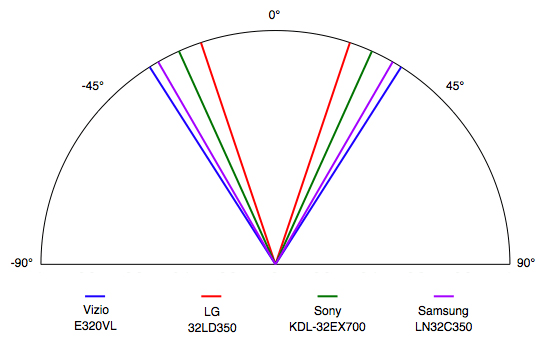
Motion Performance
{{section_header}}{{section.name}}{{/section_header}}
It's no secret that the staff here at TelevisionInfo.com are rather adamant about how awful a TV looks while displaying motion smoothing.
While the Haier L55B2181 is only a 120Hz television, its default setting is permanently infected by motion smoothing, skipping frames to create more "natural" looking motion. I guess nobody told them that there's nothing natural about a whole world trapped within a 2D screen.
Despite this unfortunate set-up, the L55B2181 still handles motion very poorly. Moving pictures depicting faces, intricate metalwork, bricks, sun shafts, and lattice patterns grew blurry and hard to watch during motion. During film content, moving objects left blurring blue/red shadows, and regularly displayed big, obvious artifacts.
The Haier L55B2181 features a "120Hz" setting, which essentially improves the strength of its already permanent motion smoothing. Users have three options for this setting: "Off," "Normal," and "Strong." Turning it on does aid with the TV's atrocious motion performance to a degree, but the difference between "normal" and "strong" settings is minimal.
No matter how you set your motion options, this TV's motion is quite terrible.
{{product.manufacturer_specs['Motion Performance Image']}}
Screen Uniformity
{{section_header}}{{section.name}}{{/section_header}}
The Haier L55B2181's screen uniformity was, at best, sub par. Its thick, charcoal-colored bezel created considerable shadow interruption along the perimeter of the screen during bright content, such as a 100% white screen. If you're watching something that's very bright or sunny, you're going to notice dimming around the edges and corners.
The Haier's unadjustable backlight proved to be a problem during dark screen content; a 100% black screen showed that the backlight will bleed through quite heavily at the corners and even partially into the center of the screen. The permanently bright CCFL backlighting does not dim to adjust to on-screen content.
Another testament to this TV's shoddy build, uniformity is a weak area.
{{product.manufacturer_specs['Screen Uniformity Image']}}
Audio Quality
{{section_header}}{{section.name}}{{/section_header}}
Haier's standalone 55-inch TV has two 10-watt speakers embedded below its bezel that face downward. Like most TVs with this audio set-up, the results were fairly poor. There's not a lot of clarity, and things like dialogue, sound effects, and music seem to always inhabit one of two possible realms: too quiet, or too loud.
The quieter sounds all meld together, so that trebles and basses have very little distinction, everything muddily settling into a middle range of sound. The louder sounds had just the opposite problem, with trebles blowing out into a tinny mess, and bass tones rumbling into obscurity as they were buried by any accompanying mid- or high tones.
This TV also has a surround mode, but like most imitation surround modes, it's not much to speak of. If you're planning on investing in this TV, you might want to also invest in a decent surround system or some headphones with a long cable.
Power Consumption
{{section_header}}{{section.name}}{{/section_header}}
The L55B2181 is not the most finely crafted of televisions that we'll review this year, and the shortcomings of its design and technological make-up are very apparent in the results of our power consumption test. Out of the three other TVs we used as comparison models--another Haier, a 55-inch from VIZIO, and a 50-inch from Insignia--the L55B2181 consumes the most power, on average.
As the chart below illustrates, users who watched this TV 4-6 hours a day, per year, would be paying an annual electricity cost of around $40, which by today's standards is fairly pricy for an LCD television. Unlike almost every other LCD on the market, the Haier L55B2181 does not allow you to change its backlight setting. It's locked at maximum, meaning there's no way to pay less per year for this TV without turning down the Brightness, which will adversely affect your color/contrast performance.
{{comparison_bars title="Average Cost Per Year", attribute="Minimum Recommended Cost per Year Measured", xLabel="Dollars"}}
Calibration
{{section_header}}{{section.name}}{{/section_header}}
Our first surprise when going into the calibration of the Haier L55B2181 was that it didn't allow for adjustment of its backlight. Most LCD televisions allow for backlight adjustment. The L55B2181 uses CCFL lighting, which is just as capable of dimming and brightening as LED LCD televisions. Why this feature is missing is a mystery that only Haier can solve.
With that established, we found it very difficult to calibrate what settings we could change on the L55B2181, and had to consult the whole TelevisionInfo team to get a "good enough" calibration, which was conducted in the TV's Custom mode. You can see the standard Haier settings, alongside our final calibration, below. This calibration gives precedence to color accuracy and spectrum, but also resulted in a very good maximum contrast ratio.
All of our calibration is done in conjunction with the DisplayMate software.
Video Modes
{{section_header}}{{section.name}}{{/section_header}}
The Haier L55B2181 has 5 video modes: Vivid, Power Saving, Standard, Mild, and Custom.
Software & Internet
Menu Interface
{{section_header}}{{section.name}}{{/section_header}}
The Picture menu (below) allows for changes to picture mode, picture settings, color temperature, blue screen, and increased motion smoothing. Blue screen simply turns on a bright blue screen that displays whenever the TV isn't receiving a signal; we're not sure what purpose that serves, other than to give your TV that "busted 90s computer monitor" feel. The 120Hz option adjusts motion smoothing, either normal or strong, though neither does much to aid this TV's motion performance.
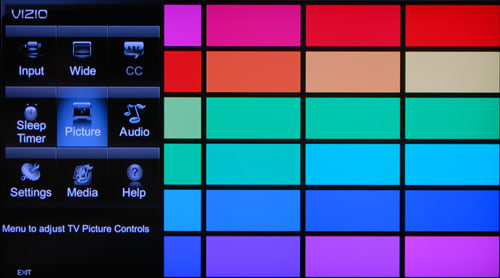
The Settings menu (below) lets you change the menu language, zoom mode, noise reduction, overscan, and to restore the TV to default (factory) settings. By the standards of yesteryear, this is a lot of options, but by the standards of 2012 it's a paltry showing.
On top of being very bare bones, these menus just aren't very attractive, and take up most of the screen with a big, solid display that makes jumping in and out of picture settings a real pain.
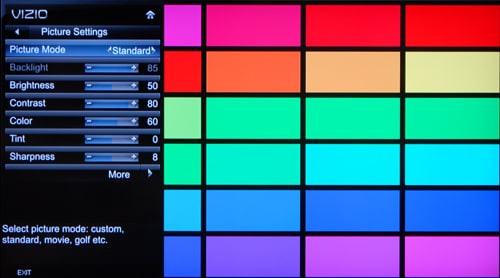
Instruction Manual
{{section_header}}{{section.name}}{{/section_header}}
The instruction manual that comes with the Haier L55B2181 is brief, black and white, and doesn't explain much beyond the basic knowledge you'll need to connect and access extraneous devices, like DVD players or video game consoles. It's simple enough to leaf through, mostly because it's really only around 20 pages long, with the second half comprising a Spanish version of the first half. Fairly standard for manuals.
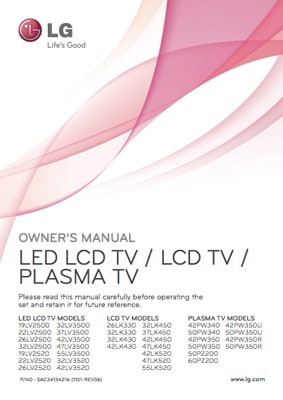
A manual for so many TV models, they have to be further categorized by type.
Conclusion
{{product.vanity}}
Haier's 55-inch model is the only screen size in the B2181 series. It's in the price range of $700-$999, depending on which retailer you buy from. The price seems decent for a 55-inch LCD, until you consider that it's an unattractive, non-3D, non-Smart, utterly inflexible product.
We could come to an understanding of this TV's value, if only its performance had been better. It's got decent color and a good contrast ratio, but most of your viewing experiences are going to be run aground by its horrible audio and motion. Even if a picture looks good where color is concerned, it's hard to enjoy it when any sort of motion leaves discolored, shadowy streaks, and is probably accompanied by the sound of a rubber cat being sucked into a black hole.
The bottom line is, there are cheaper, better performing, better looking TVs on the market. It would be one thing if this TV had the slimmest price tag available, but it doesn't, and for that reason we can't see any incentive to pursue it as a purchase.
Photo Gallery
{{photo_gallery "Design Landing Page Photo", "Front Tour Image", "Back Tour Image", "Sides Tour Image", "Connectivity Tour Image 1", "Connectivity Tour Image 2", "Stand Photo", "Controls Photo", "Remote Control Photo", "3D Landing Page Photo", "3D Menu Photo", "3D Glasses Photo", "Connectivity Extra Photo", "Software and Internet Landing Page Photo", "Menu Main Photo", "Menu 2 Photo", "Instruction Manual Photo", "Internet Features 1 Photo", "Internet Features 2 Photo", "Internet Features 3 Photo", "Local Media Playback 1 Photo", "Local Media Playback 2 Photo", "Browser 1 Photo", "Browser 2 Photo", "Browser 3 Photo", "Apps 1 Photo", "Apps 2 Photo", "Apps 3 Photo"}}
Ratings & Specs
{{manufacturer_specs_table}}
Meet the tester
Lee was Reviewed's point person for most television and home theater products from 2012 until early 2022. Lee received Level II certification in TV calibration from the Imaging Science Foundation in 2013. As Editor of the Home Theater vertical, Lee oversaw reviews of TVs, monitors, soundbars, and Bluetooth speakers. He also reviewed headphones, and has a background in music performance.
Checking our work.
Our team is here to help you buy the best stuff and love what you own. Our writers, editors, and experts obsess over the products we cover to make sure you're confident and satisfied. Have a different opinion about something we recommend? Email us and we'll compare notes.
Shoot us an email

